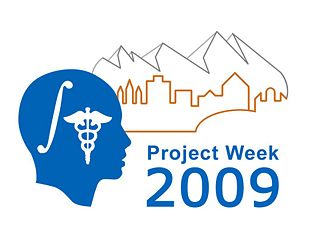2009 Winter Project Week fMRI Clustering
 Return to Project Week Main Page |
Key Investigators
- MIT: Archana Venkataraman
- BWH: Marek Kubicki
- MIT: Polina Golland
Objective
We are developing methods to characterize differences between healthy subjects and patients with Schizophrenia. Our work uses resting state fMRI data to pinpoint brain regions with "similar" voxel time courses. Resting state data is thought to capture spontaneous, low-frequency oscillations in the brain, and it is commonly used for functional connectivity analysis. The goal of this work is to pinpoint brain structures which are indicative of each population (healthy vs. Schizophrenic).
Approach, Plan
Our approach is to use clustering methods to partition the whole brain into functionally coherent regions. Currently, the most common approach for functional connectivity analysis is seed-based correlation analysis. This method requires the user to identify a "seed" region of interest and identifies voxels significantly correlated with the mean time course of this ROI. In contrast, clustering algorithms are entirely data-driven and do not require any prior information about the brain's spatial or functional organization.
We consider two different clustering algorithms: K-Means clustering and Spectral Clustering. To enable clustering of the entire brain volume, we use the Nystrom Method to approximate the necessary spectral decompositions.
Our plan for project week is to start pre-processing the new dataset of healthy subjects and schizophrenia patients using FSL. This includes standard fMRI preprocessing as well as additional preprocessing for functional connectivity analysis. If time permits, we would like to obtain preliminary clustering results and understand the strengths/limitations of the above clustering methods.
Progress
Software for the registration between electrophysiology Carto data and the MR angiogram has been implemented, using the ITK/VTK platform (see ISMRM 2008 abstract, Taclas et al, and figure above). This week we wrote code to quantitatively determine the distances between each ablation location, and the closest region of scar, and to determine the distances between each pixel of scar, and the nearest ablation point. Therefore we accomplished our goal!
References
- Peters DC, Wylie JV, Hauser TH, Kissinger KV, Botnar RM, Essebag V, Josephson ME, Manning WJ. Detection of pulmonary vein and left atrial scar after catheter ablation with three-dimensional navigator-gated delayed enhancement MR imaging: initial experience. Radiology 2007; 243:690-695.
- Taclas JE, Wylie JV, Hauser TH, Manning WJ, Josephson ME, Peters, DC. Correlation and Visualization of Left Atrial Scar due to Pulmonary Vein Ablation with Recorded Ablation Sites. Proceedings of the 16th scientific meeting of the International Society for Magnetic Resonance in Medicine (2008), Toronto, CA, p. 1042.
- Malchano ZJ, Neuzil P, Cury RC, Holmvang G, Weichet J, Schmidt EJ, Ruskin JN, Reddy VY. Integration of cardiac CT/MR imaging with three-dimensional electroanatomical mapping to guide catheter manipulation in the left atrium: implications for catheter ablation of atrial fibrillation. J Cardiovasc Electrophysiol 2006; 17:1221-1229.